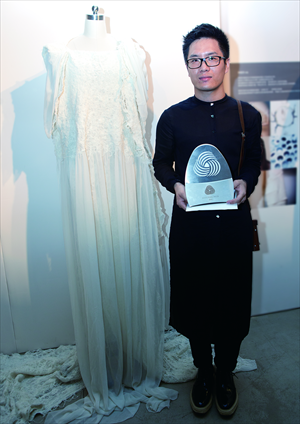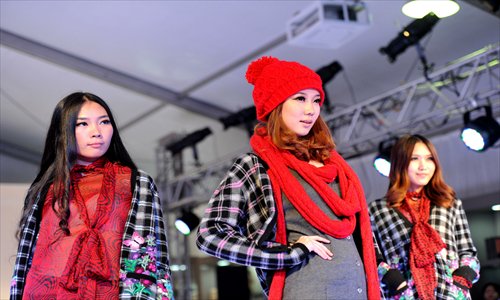Warming up to wool


The International Woolmark Prize (IWP), first launched in 1953 to raise the profile of wool in the fashion industry by celebrating the work of innovative designers, has been re-launched this year after an absence of about two decades. China is among the five countries and regions from which semi-finalists have been chosen for the final round, marking the country's role as a top influence in the fashion world.
On July 12, it was announced that China's Ban Xiaoxue will join other young designers from Europe, the US, India and Australia in February 2013 during London Fashion Week in the competition for the grand prize, which has been awarded to fashion giants Yves Saint Laurent and Karl Lagerfeld.
Ban feels a deep connection to his chosen material of wool, and he experimented with different fiber treatments before creating Growth, the line that landed him in competition for the IWP. Ban's pieces are made with fabric woven from Merino wool blended with a bit of silk, lending the clothing an elegant, draped effect.
"Merino wool is soft and fine," the Chinese finalist said at the awards ceremony. "It breathes well and really keeps you warm. What's more, it's especially versatile."
Ban's Chinese competition put forth valiant efforts with unique and expressive fashions. Designer Liu Fang used 100 percent Merino wool and special knitting techniques to deliver futuristic and sculptural effects. The work of designer Ni Hua took inspiration from Japanese samurai and applied it to womenswear to express the tough tenderness and natural elegance of femininity. Another contender, Yu Wanning, crossed apparel design with abstract art in her line, Mirage, with pieces that resemble paintings more than clothes.
Good material
These designs were chosen as contenders for the IWP for their ability to showcase the versatility of wool, which was first used by northern European tribes thousands of years ago.
Compared with cashmere, which is famous for its softness, good heat retention, lightness, and vibrant array of colors, wool has some distinct advantages. As wool fiber is stronger and longer than that of cashmere, it is less prone to wear and tear, making it suitable for outerwear. Wool also has better acid and alkali resistance, leaving material largely unblemished after contact with chemicals. Most importantly, wool is significantly cheaper than cashmere.
"Cashmere comes from goats and wool comes from sheep," said Adele Jin, business development director of the Woolmark Company.
"Five goats can produce only one cashmere sweater every year," said Liu Feifei, copy writer for Inner Mongolia Erdos Cashmere Co, Ltd. If all cashmere production in an entire year were made into sweaters, there would be one sweater for every 5,000 people on Earth, Liu explained. Alternately, if annual wool production were limited to sweaters only, each person on the planet would get two sweaters. "Therefore, cashmere, the so-called 'soft gold' which is priced by the gram on the international market, is much more expensive than wool," Liu told the Global Times.
Introducing novelty
While wool is a superb material, its development in China's fashion arena has been somewhat limited in comparison to the rest of the world due to a lack of innovation in design.
"Nowadays, in many other countries, a lot of research and development takes place in the field of woolen apparel," said Sharlene Zhu, communications director of the International Fur Trade Federation China Office. "However, there has been very little of this in China. At a time when the industry focuses on branding in Western countries, our domestic industry lacks high-end designer brands. Most styles and designs are old-fashioned and thus the development of the wool industry is quite restricted."
Many Chinese designers and fashion operations have recently undertaken ambitious projects to expand their use of wool in response to this void.
"In recent years many beneficial explorations have been made in the field, and much research on the material has already been adopted in factory-made fashions, largely raising the additional value of the clothes," Zhu told the Global Times.
"In the past, woolen products were generally regarded as clothes for middle-aged people and thought to be suitable only during autumn and winter. But these days, more and more young people are embracing woolen clothing, and many are wearing the material in different seasons," said Liu Feifei.
Getting in on innovation
Woolmark, known for its leadership in the wool industry, has set quite the pace for wool businesses worldwide.
"We always keep on innovating. In addition to expanding on earlier methods, we also blend wool with other fibers, such as denim, silk, linen and so on, to realize different effects," Jin told the Global Times.
"Woolen products actually have changed little in terms of texture, but weaving and staining methods have improved a lot," Hong Xiantao, operations director of Shanghai Weijun Woolen Products, told the Global Times. "For example, many producers have adopted German machinery and weaving techniques, and use full computer staining techniques."
Liu told the Global Times that Inner Mongolia Erdos Cashmere Co, Ltd, cooperates with crystal producer Swarovski and former art director of Chanel Gilles Dufour to explore and design new products, resulting in a complete series of woolen clothes combined with silk, cotton and other materials.
"We have also developed some functional products, such as antistatic material, nanomaterial, and rainbow yarn," said Liu.
The development of woolen clothing in China's fashion industry is fast approaching industry standards on the international stage.
"In the past, woolen materials, without being specially processed, were still more prone to pilling after lengthy use compared with other fibers," said the owner of Paris Spring 1898, an online store specializing in haute couture clothing. "But recently, other imported materials have been blended with wool and processed through special techniques, largely solving the problem of pilling," she told the Global Times.